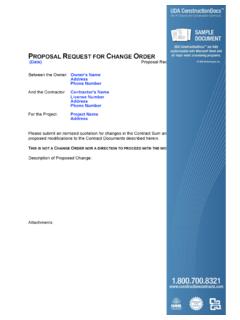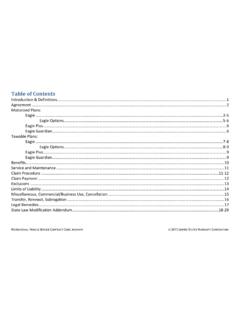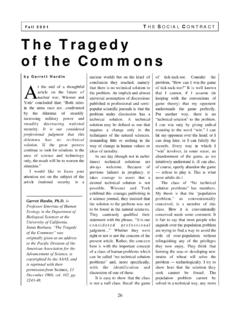Transcription of A GUIDE TO CONTRACT INTERPRETATION
1 A GUIDE TOCONTRACTINTERPRETATIONJuly 2014byVincent R. Martorana July 2014 Reed Smith LLPAll rights GUIDE is intended for an audience of attorneys and does not constitute legal advice please see Scope of this GUIDE and Disclaimer. TABLE OF CONTENTS i CONTENTS PAGE I. INTRODUCTION .. 1 A. Purpose of this GUIDE .. 1 B. Scope of this GUIDE and Disclaimer .. 2 C. Author Bio .. 3 II. CONTRACT - INTERPRETATION FLOW CHART .. 4 III. CONTRACT - INTERPRETATION PRINCIPLES AND CASE-LAW SUPPLEMENT .. 5 A. Determine the intent of the parties with respect to the provision at issue at the time the CONTRACT was made .. 5 B. Defining ambiguity .. 6 1. A CONTRACT or provision is ambiguous if it is reasonably susceptible to more than one INTERPRETATION .. 6 a. Some courts look at whether the provision is reasonably susceptible to more than one INTERPRETATION when read by an objective reader in the position of the parties.
2 8 b. Some courts factor in a reading of the provision by one who is cognizant of the customs, practices, and terminology as generally understood by a particular trade or business .. 10 i. Evidence of custom and practice in an industry is admissible to define an unexplained term .. 10 ii. When the plain meaning of a word lends itself to only one reasonable INTERPRETATION , that INTERPRETATION controls .. 11 c. The CONTRACT should be viewed in light of the circumstances under which it was made .. 13 d. As between two interpretations, the court will not adopt an INTERPRETATION that produces an absurd result .. 14 e. Contracts should be construed in a commercially reasonable manner .. 15 f. A provision is not ambiguous simply because the parties disagree as to its construction or urge alternative interpretations.
3 16 ii CONTENTS PAGE C. Assessing whether a provision is ambiguous .. 17 1. Whether a CONTRACT or provision is ambiguous is a determination of law for the court to make on a claim-by-claim basis .. 17 2. Parol evidence cannot be used to create an ambiguity .. 18 3. Principles for determining whether a provision is ambiguous 19 a. Holistic Principles .. 19 i. Read the CONTRACT as a whole; do not read provisions in a vacuum .. 19 ii. Provisions and terms should not be interpreted so as to render any provision or term superfluous or meaningless .. 21 iii. The terms of the CONTRACT should be harmonized and read in context1 .. 23 iv. Contracts entered into contemporaneously and for the same purpose should be read and interpreted together .. 23 b. Canons of Construction .. 24 i.
4 Ejusdem generis .. 24 ii. Expresio unius est exclusio alterus .. 26 iii. The specific governs over the general .. 26 iv. The same words used in different parts of a writing have the same meaning .. 26 c. Other Principles2 .. 27 i. In determining whether an ambiguity exists, courts look at the language of the CONTRACT itself and the inferences that can be drawn from that language ..27 1 Query whether harmonize means (1) to interpret a provision so as to reduce or eliminate surplusage or (2) to let other provisions (which might or might not be superfluous) GUIDE the selection of one alternative INTERPRETATION over another. Meaning #2 is slightly broader. 2 In addition to the principles listed below, there are various additional principles (which are not addressed in this GUIDE ) that a court might employ to determine whether or not a provision is ambiguous.
5 Iii CONTENTS PAGE ii. Preference for construing text as obligation rather than a condition ..27 iii. When dealing with sophisticated parties, the court gives deference to the language used .. iv. Contractual silence does not necessarily create ambiguity, but an omission as to a material issue can create an ambiguity .. v. Punctuation is always subordinate to the text and is never allowed to create ambiguity or undermine otherwise clear meaning .. 28 29 29 D. When a provision is unambiguous .. 30 1. If the provision is unambiguous, then the court interprets the CONTRACT as a matter of law .. 30 2. If the provision is unambiguous, then the court should look only to the text of the CONTRACT to determine the parties intent and parol evidence should not be used ( four-corners rule ).
6 31 a. If the provision is unambiguous, then the court cannot use notions of equity and fairness to alter the CONTRACT .. 32 E. When a provision is ambiguous .. 33 1. If the provision is ambiguous, then the parties intent becomes a question of fact .. 33 2. If the provision is ambiguous [or incomplete], then parol evidence can be used to determine the intent of the parties . 34 3. If the provision is ambiguous, then summary judgment is not appropriate unless the parol evidence is uncontroverted or so one-sided that no reasonable person could decide otherwise .. 35 4. An ambiguity is generally construed contra proferentum ( , against the drafter), particularly in adhesion contracts ..37 a. Courts are divided as to whether the rule of contra proferentum applies prior to or after considering parol evidence.
7 38 i. Some courts apply the rule of contra proferentum as one of last resort, ( , only after considering extrinsic evidence) ..39 iv CONTENTS PAGE ii. Ambiguities in adhesion contracts ( certificates of incorporation, insurance contracts) should be construed against the drafter without considering extrinsic evidence ..40 b. Parties can CONTRACT around the contra proferentum rule .. 42 5. A whereas clause cannot create any rights arising from beyond the CONTRACT s operative terms ..42 F. Specific substantive and miscellaneous areas of CONTRACT interpretation3 .. 42 1. Arbitration .. 42 a. There is a strong public policy in favor of arbitration, in light of which courts should seek an INTERPRETATION that honors the parties decision to resolve disputes by arbitration, permits an arbitration clause to remain in effect, and resolves ambiguities regarding the scope of applicability of such clause in favor of arbitration.
8 42 b. An arbitrator exceeds his or her powers only if the court can find no rational construction of the CONTRACT that can support the award .. 43 c. Arbitration will not always be used to resolve an ambiguity with respect to the scope of an arbitration provision.. 44 2. Certificate of Incorporation .. 44 a. In the INTERPRETATION of certificates of incorporation, the same rules of construction apply as are applicable to contracts generally .. b. When a certificate of incorporation is ambiguous, the court looks at extrinsic evidence to determine the common understanding of the language in controversy .. 44 44 c. Unless the extrinsic evidence resolves the ambiguity with clarity in favor of the Preferred Stockholders, the CONTRACT should be interpreted in the manner that is least restrictive of electoral rights .. 46 3 Listed below are principles of CONTRACT INTERPRETATION that are specific to certain substantive areas of contracts.
9 These principles are based solely upon the limited case law that was reviewed in connection with compiling this GUIDE and this GUIDE does not purport to include a complete set of all such types of CONTRACT - INTERPRETATION principles. v CONTENTS PAGE 3. Subordination .. 47 a. Where the terms of one provision are expressly stated to be subject to the terms of a second provision, the terms of the second provision will control, even if the terms of the second provision conflict with or nullify the first .. 47 4. CONTRACT Formation .. 47 a. General principles of CONTRACT formation are used to determine whether the parties intended to form a binding agreement .. 47 5. Captions and Section 48 a. Absent language in a CONTRACT to the contrary, section headings in that CONTRACT are to be given effect in interpreting and construing that CONTRACT .
10 48 6. ERISA .. 48 a. ERISA plan documents are construed using traditional rules of CONTRACT INTERPRETATION , as long as they are consistent with federal labor policies .. 48 7. Holding Agents in Escrow .. 49 a. Placing a signed CONTRACT in escrow is simply a way of creating a condition precedent to the CONTRACT s validity .. 49 8. Indemnification Provisions .. 50 a. The court will interpret a CONTRACT to avoid reading into it a duty to indemnify that the parties did not intend to be assumed .. 50 9. Motion to Dismiss .. 50 a. When ruling on a motion to dismiss, the court must resolve all ambiguities in the CONTRACT in favor of the plaintiff .. 50 b. A contractual statute of limitations is generally respected in NY courts .. 51 10. Proprietary Lease .. 51 a. In the INTERPRETATION of leases, the same rules of construction apply as are applicable to contracts generally.







